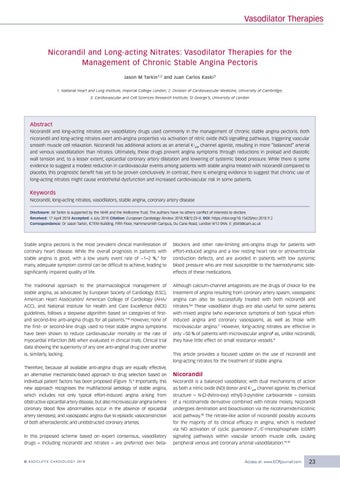Vasodilator Therapies
Nicorandil and Long-acting Nitrates: Vasodilator Therapies for the Management of Chronic Stable Angina Pectoris Jason M Tarkin 1,2 and Juan Carlos Kaski 3 1. National Heart and Lung Institute, Imperial College London; 2. Division of Cardiovascular Medicine, University of Cambridge; 3. Cardiovascular and Cell Sciences Research Institute, St George’s, University of London
Abstract Nicorandil and long-acting nitrates are vasodilatory drugs used commonly in the management of chronic stable angina pectoris. Both nicorandil and long-acting nitrates exert anti-angina properties via activation of nitric oxide (NO) signalling pathways, triggering vascular smooth muscle cell relaxation. Nicorandil has additional actions as an arterial K+ATP channel agonist, resulting in more “balanced” arterial and venous vasodilatation than nitrates. Ultimately, these drugs prevent angina symptoms through reductions in preload and diastolic wall tension and, to a lesser extent, epicardial coronary artery dilatation and lowering of systemic blood pressure. While there is some evidence to suggest a modest reduction in cardiovascular events among patients with stable angina treated with nicorandil compared to placebo, this prognostic benefit has yet to be proven conclusively. In contrast, there is emerging evidence to suggest that chronic use of long-acting nitrates might cause endothelial dysfunction and increased cardiovascular risk in some patients.
Keywords Nicorandil, long-acting nitrates, vasodilators, stable angina, coronary artery disease Disclosure: JM Tarkin is supported by the NIHR and the Wellcome Trust. The authors have no others conflict of interests to declare. Received: 17 April 2018 Accepted: 6 July 2018 Citation: European Cardiology Review 2018;13(1):23–8. DOI: https://doi.org/10.15420/ecr.2018.9.2 Correspondence: Dr Jason Tarkin, ICTEM Building, Fifth Floor, Hammersmith Campus, Du Cane Road, London W12 0NN. E: jt545@cam.ac.uk
Stable angina pectoris is the most prevalent clinical manifestation of coronary heart disease. While the overall prognosis in patients with stable angina is good, with a low yearly event rate of ~1–2 %,1 for many, adequate symptom control can be difficult to achieve, leading to significantly impaired quality of life.
blockers and other rate-limiting anti-angina drugs for patients with effort-induced angina and a low resting heart rate or atrioventricular conduction defects, and are avoided in patients with low systemic blood pressure who are most susceptible to the haemodynamic sideeffects of these medications.
The traditional approach to the pharmacological management of stable angina, as advocated by European Society of Cardiology (ESC), American Heart Association/ American College of Cardiology (AHA/ ACC), and National Institute for Health and Care Excellence (NICE) guidelines, follows a stepwise algorithm based on categories of firstand second-line anti-angina drugs for all patients.1–3 However, none of the first- or second-line drugs used to treat stable angina symptoms have been shown to reduce cardiovascular mortality or the rate of myocardial infarction (MI) when evaluated in clinical trials. Clinical trial data showing the superiority of any one anti-anginal drug over another is, similarly, lacking.
Although calcium-channel antagonists are the drugs of choice for the treatment of angina resulting from coronary artery spasm, vasospastic angina can also be successfully treated with both nicorandil and nitrates.5,6 These vasodilator drugs are also useful for some patients with mixed angina (who experience symptoms of both typical effortinduced angina and coronary vasospasm), as well as those with microvascular angina.7 However, long-acting nitrates are effective in only ~50 % of patients with microvascular angina8 as, unlike nicorandil, they have little effect on small resistance vessels.9
Therefore, because all available anti-angina drugs are equally effective, an alternative mechanistic-based approach to drug selection based on individual patient factors has been proposed (Figure 1).4 Importantly, this new approach recognises the multifactorial aetiology of stable angina, which includes not only typical effort-induced angina arising from obstructive epicardial artery disease, but also microvascular angina (where coronary blood flow abnormalities occur in the absence of epicardial artery stenoses), and vasospastic angina due to episodic vasoconstriction of both atherosclerotic and unobstructed coronary arteries. In this proposed scheme based on expert consensus, vasodilatory drugs – including nicorandil and nitrates – are preferred over beta-
© RADCLIFFE CARDIOLOGY 2018
ECR_Tarkin_FINAL.indd 23
This article provides a focused update on the use of nicorandil and long-acting nitrates for the treatment of stable angina.
Nicorandil Nicorandil is a balanced vasodilator, with dual mechanisms of action as both a nitric oxide (NO) donor and K+ATP channel agonist. Its chemical structure – N-[2-(Nitro-oxy) ethyl]-3-pyridine carboxamide – consists of a nicotinamide derivative combined with nitrate moiety. Nicorandil undergoes denitration and bioactivation via the nicotinamide/nicotinic acid pathway.10 The nitrate-like action of nicorandil possibly accounts for the majority of its clinical efficacy in angina, which is mediated via NO activation of cyclic guanosine-3’,-5’-monophosphate (cGMP) signaling pathways within vascular smooth muscle cells, causing peripheral venous and coronary arterial vasodilatation.11,12
Access at: www.ECRjournal.com
23
01/08/2018 14:34
